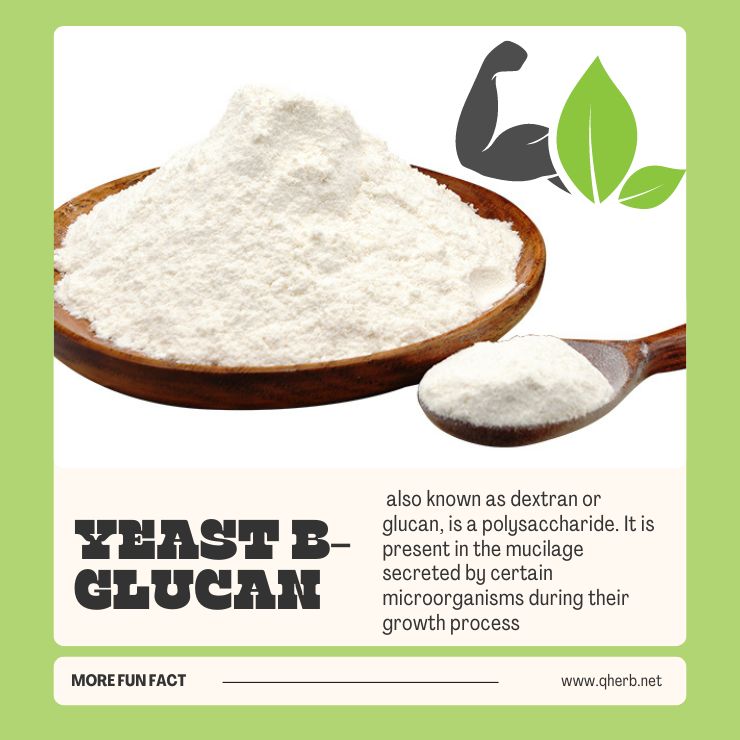What is the first discovered polysaccharide Yeast β-glucan with immunological activity?
Yeast β-glucan, also known as dextran or glucan, is a polysaccharide. It is present in the mucilage secreted by certain microorganisms during their growth process. Modern research has found that the β-glucans found in certain fungi, such as Agaricus blazei Murill, are abundant and possess high biological activity. β-glucans typically have high molecular weights and are primarily composed of D-glucose units linked by α,1→6 glycosidic bonds, with branching points occurring through 1→2, 1→3, and 1→4 linkages. Among them, β-glucans with β-1,3/-1,6 linkages exhibit the highest biological activity. The structure and function of β-glucans vary depending on the species of microorganism and growth conditions.
Numerous experiments have demonstrated that β-glucans can promote the production of IgM antibodies in the body, thus enhancing humoral immunity. Activation of cells by these glucans stimulates the host’s nonspecific defense mechanisms, making them particularly promising in treating tumors, infections, and wound healing. β-1,3-glucans extracted from Agaricus blazei Murill through specific procedures and devoid of endotoxins have been recognized by the U.S. FDA as safe substances. They can be incorporated into healthy foods, and many studies have shown that oral administration of yeast β-1,3-glucans in mice can enhance peritoneal macrophage phagocytosis.
Yeast β-glucan is a polysaccharide found in the cell walls of yeast with potent immunostimulatory properties. β-glucans are widely distributed in various fungi and plants, such as Agaricus blazei Murill, shiitake mushrooms, reishi mushrooms, and oats, serving as the main active ingredients for their health-promoting effects. Yeast β-glucans exhibit stronger immune-enhancing activity and also possess functions such as improving lipid profiles, detoxification, radiation protection, cell repair, and enhancing intestinal function.
Extraction Methods
There has been extensive research on the extraction processes of yeast β-glucans, both domestically and internationally, including acid extraction, alkali extraction, acid-base combined extraction, and organic solvent extraction methods.
- Acid Extraction
Research has been conducted on whether acetic acid, formic acid, or phosphoric acid is suitable for acid hydrolysis extraction of yeast β-glucans, and the results indicate that the main structure and branching structure of β-glucans is not significantly altered after acid hydrolysis. Acetic acid was found to be optimal for extracting β-glucans from brewer’s yeast under the following conditions: acetic acid concentration of 6%, extraction temperature of 90°C, extraction time of 6 hours, and a solid-liquid ratio of 1:6. Under the optimal extraction conditions, the yield of yeast β-glucans was 21.58%, with a protein content of 7.21% and a polysaccharide content of 71.46%. Paper chromatography experiments showed that the hydrolysis products contained both mannose and glucose.
Although acid extraction yields high quantities of β-glucans, it also results in significant amounts of mannose and protein content and can lead to degradation of polysaccharides.
- Alkali Extraction
Cell walls are suspended in a 3% (w/v) NaOH solution and left at 4°C for 9 days. The portion suspended on the surface is intermittently removed, and the remaining portion is centrifuged for 15 minutes to obtain cell wall residue. By adding ethylenediaminetetraacetic acid to adjust the pH of the removed solution to 10, a colloid forms, which is then centrifuged for 30 minutes to obtain the substance, washed thoroughly with water, and redispersed in a 3% (w/v) NaOH solution. When the solution pH is adjusted to 10, β-glucans precipitate again. Paper chromatography indicates that glucose is the main product after hydrolysis with 2 mol/L H2SO4.
Domestic and international research indicates that alkali extraction results in higher purity, and lower protein residue, but lower polysaccharide yield. However, extensive use of alkali can lead to environmental pollution and polysaccharide degradation.
- Acid-Base Combined Extraction
Yeast is dispersed in a NaOH solution, stirred, and then water is added. The precipitate is collected by centrifugation. The precipitate is redispersed in a NaOH solution, and the process is repeated. The precipitate is washed three times with water, then extracted with HCl, centrifuged to collect the precipitate, and dried to obtain yeast β-(1,3)-D-glucan products.
Although the purity of products obtained through acid-base combined methods is higher with less protein content and higher yield, the process is complex, laborious, time-consuming, and involves the use of multiple organic solvents for dehydration, resulting in more waste and environmental pollution.
- Others
Traditional acid-base treatment methods for preparing yeast β glucan involve large amounts of acid and alkali, are cumbersome, and involve high labor intensity. The use of acid and alkali in extraction can easily lead to polysaccharide degradation, affecting the physiological activity of β-glucans.

Comments
Post a Comment